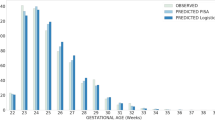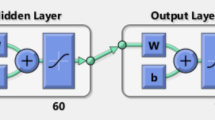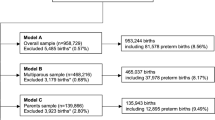Abstract
The aim of this study was to produce models for the prediction of high risk pregnancies, with particular emphasis on pre-term delivery. Neural network and logistic regression models have been developed utilising pregnancy and delivery data spanning a period of seven years. Five input factors were used as explanatory variables: age, number of previous still births, gestational age at first clinical assessment, diabetes and a measure of socio-economic status. There was little difference between average model performance for the two techniques: optimal neural network performance was achieved with a fully connected feed forward network comprising a single hidden layer of three nodes and single output node. This produced a Receiver Operating Characteristic (ROC) curve area of 0.700. The ROC area for logistic regression models was 0.695. The performance of these models reflected weak associations within the data. However, performance is encouraging given the relatively limited number of predictive inputs.
Similar content being viewed by others
References
Audit commission. First class delivery: improving maternity services in England and Wales, 1997
Chamberlain G, Philip E, Howlett B, Masters K. British Births. 1970 volume 2, Obstetric care. William Heinmann Medical Books, 1978
Creasy RK, Beverly A, Gummer NZ, Graham C, Liggins MD. System for predicting spontaneous preterm birth. Obstetrics and Gynaecology 1980; 55(6): 692–695
Huesten WJ. Development of a Caesarean delivery risk score. Obstetrics and Gynaecology 1994; 84: 965–968
Martel M, Wacholder S, Lippman A, Brohan J, Hamilton E. Maternal age and primary Caesarean section rates: a multivariate analysis. Am J Obstetrics and Gynaecology 1987; 156: 30–38
Huesten WJ, Rudy M. Factors predicting elective repeat Caesarean delivery. Obstetrics and Gynaecology 1994; 83: 741–744
Knox AJ, Sadler MB, Pattison NS, Mantell CD, Mullins P. An obstetric scoring system: its development and application in obstetric management. Obstetrics and Gynaecology 1993; 81: 195–199
Narayanan MN, Lucas SB. A genetic algorithm to improve a neural network to predict a patients' response to warfarin. Methods of Informatics in Medicine 1993; 32: 55–58
Tarassenko L, Whitehouse R, Gasparini G, Harris AL. Neural network prediction of relapse in breast cancer patients. Neural Comput Applic 1996; 4(2): 105–113
Beksac MS, Durak B, Ozkan O, Cahar AN, Baki S, Karakas I, Leleli Y. An artificial intelligent diagnostic system with neural networks to determine genetic disorders and foetal health by using maternal serum markers. Euro J Obstetrics and Gynaecology and Reproductive Biology 1995; 59: 131–136
Rumellhart DE, Hinton GE, Williams RJ. Learning representations by back propagating errors. Nature 1986; 323: 533–536
Ripley BD. Pattern Recognition and Neural Networks. Oxford University Press, 1996
Department of Trace and Industry. Neural computing — learning solutions. Best practice guidelines for developing neural computing applications, 1994
Bishop CM. Neural networks for pattern recognition. Clarendon Press, 1995
Ripley BD. Neural networks and related methods for classification. JR Statist Soc 1994; 56(3): 409–456
Armitage P. Statistical Methods in Medical Research. Blackwell Scientific, 1971
Ingram D, Block R. Mathematical Methods in Medicine. Part 1: Statistical and analytical techniques. Wiley, 1994
Flury B, Riedwyl H. Multivariate statistics — a practical approach. Chapman & Hall, 1988
Spackman KA. Combining logistic regression and neural networks to create predictive models. Proc Ann Symposium on Computer Applications in Medical Care 1993; 456–459
Beale R and Jackson T. Neural Computing — An Introduction. Institute of Physics Publishing, 1990
Hornik K. Approximation capabilities of multilayer feed-forward networks. Neural Networks 1991; 4(2): 251–257
Kreinovich VY. Arbitrary nonlinearity is sufficient to represent all functions by neural networks: a theorem. Neural Networks 1991; 4(3); 381–383
Jarman B. Underprivileged areas: validation and distribution of scores. Br Medical J 1984; 289: 1585–1588
Hinton GE. Connectionist learning procedures. Artif Intell 1989; 40: 185–234
Gori M, Tesi A. On the problem of local minima in back-propagation. IEEE Trans Patt Anal Mach Int 1992; 14(1): 76–85
Amirikan B, Nishimura H. What size network is good for generalization of a specific task of interest? Neural Networks 1994; 7(2): 321–329
Wasserman PD. Neural Computing: Theory and practice. Von Nostrand Reinhold, 1989
SAS Institute Inc. SAS/Stat Users Guide. Volumes 1 and 2, 1994
Henderson AR. Assessing test accuracy and its clinical consequences: a primer for receiver operating characteristic curve analysis. Ann Clin Biochem 1993; 30: 521–539
Strike PW. Statistical Methods in Laboratory Medicine. Butterworth-Heinemann, 1991
Vining DJ, Gladish GW. Receiver operating characteristic curves: a basic understanding. Radiographics 1992; 12: 1147–1150
Author information
Authors and Affiliations
Rights and permissions
About this article
Cite this article
Eastaugh, J.L., Smye, S.W., Snowden, S. et al. Comparison of neural networks and statistical models to predict gestational age at birth. Neural Comput & Applic 6, 158–164 (1997). https://doi.org/10.1007/BF01413827
Issue Date:
DOI: https://doi.org/10.1007/BF01413827




